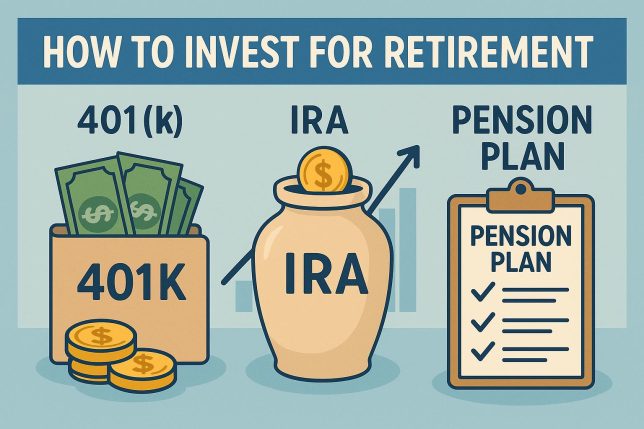Understanding Retirement Investment Options
Investing for retirement is a pivotal aspect of financial planning that can profoundly influence your financial well-being in the later stages of life. With a plethora of investment choices available, it is vital to comprehend the different opportunities and their unique benefits and limitations. This article elaborates on three prevalent retirement investment avenues: 401(k) plans, Individual Retirement Accounts (IRAs), and pension plans. Gaining a thorough understanding of these options is essential to crafting a sound retirement savings strategy tailored to your specific needs and goals.
401(k) Plans
A 401(k) plan stands as one of the cornerstones in retirement savings for many employees. As an employer-sponsored retirement savings account, it facilitates a seamless way to set aside a portion of your pre-tax salary for future needs. One of the principal advantages is the automatic deduction from your paycheck, which promotes a consistent saving habit without needing manual transfers or reminders. In addition to being convenient, this plan is often bolstered by the possibility of employer matching contributions. Essentially, some employers may match a portion of your contributions, providing an accelerated growth potential for your nest egg.
From a taxation perspective, a 401(k) offers noteworthy advantages. Contributions are executed with pre-tax dollars, which effectively reduces your taxable income for the year. This benefit not only potentially lowers your current-year tax obligations but also allows your investment to grow on a tax-deferred basis. This means you will only pay taxes on the withdrawals made during retirement when generally, you may find yourself in a lower tax bracket. This key feature makes the 401(k) an attractive option for those looking for systematic investment and tax efficiency. For those interested in delving deeper into the mechanics of 401(k) plans, further resources are available.
Individual Retirement Accounts (IRAs)
Individual Retirement Accounts (IRAs) offer another powerful mechanism for building retirement savings, presenting two primary flavors: the Traditional IRA and the Roth IRA. While each type serves the overarching purpose of retirement savings, they achieve their tax benefits through different methodologies.
The Traditional IRA allows your contributions potentially to be tax-deductible, which can directly reduce your tax burden for the current year. Similar to a 401(k), the account’s funds grow tax-deferred, implying that you will pay income taxes only upon withdrawal during retirement. This deferral enables potential capital growth without the immediate drag of taxes, allowing for compounded growth over time.
On the flip side, a Roth IRA requires contributions with after-tax dollars. Although you won’t benefit from an upfront tax deduction, the true advantage of this account is realized during withdrawal. Qualified withdrawals from a Roth IRA, including earnings, are entirely tax-free, provided certain conditions are met. This can be significantly beneficial if you anticipate being in a higher tax bracket when you retire, as it ensures a tax-exempt income in your future years.
Overall, the choice between a Traditional and Roth IRA hinges on your current financial situation and tax perspectives regarding both present conditions and future predictions. For those seeking more detailed information regarding IRAs, there are numerous resources available.
Pension Plans
Pension plans, otherwise known as defined benefit plans, offer a unique approach to retirement funding compared to 401(k)s and IRAs. Unlike the individual-driven nature of the former plans, pension plans are usually employer-funded, with the employer bearing the investment risk. The defining characteristic of a pension plan is the assurance of a specific payout at retirement, which is generally contingent upon factors like your salary history and the length of employment. This circumstance affords retirees a dependable income stream, offering financial stability in retirement.
However, it is crucial to recognize the evolving landscape of pension plans. The prevalence of traditional pensions has waned, especially within the private sector, making it imperative to seek additional retirement investments. Relying solely on a pension may not suffice to meet all financial needs in retirement. Hence, integrating pensions with additional plans can provide a more robust retirement portfolio. For those wishing to explore the nuances of pension plans, a variety of resources are accessible for further research.
Choosing the Right Plan
Selecting the appropriate retirement investment strategy requires careful consideration of numerous individual factors, such as your employment status, the potential tax ramifications, and your long-term retirement goals. More often than not, individuals find that leveraging a combination of retirement accounts—such as a 401(k), an IRA, and additional savings vehicles—can amplify their savings and tax efficiency. This diversified approach spreads both risk and opportunity, ultimately paving the way for a more secure financial future. Consulting with a financial advisor can provide personalized insight on optimizing your retirement strategy, ensuring it aligns seamlessly with your unique circumstances and financial aspirations.
Conclusion
A successful retirement plan demands a thorough understanding of the various investment options available and thoughtful selection aligned with personal financial goals. Whether opting for a 401(k) plan, an IRA, or relying partly on a pension, initiating early and maintaining a steady contribution routine lays the foundation for a comfortable and secure retirement. As the landscape of retirement planning evolves, staying informed and adaptable remains crucial to achieving the desired financial independence and stability in one’s golden years.





